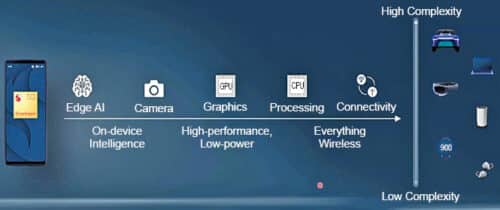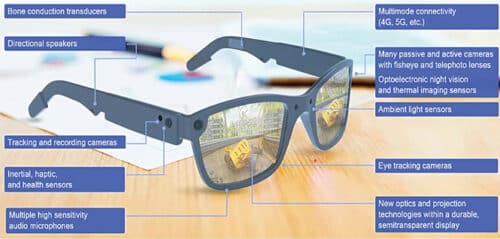It’s a pretty exciting time for mobile architecture since the world is currently struggling with the gradual decline of Moore’s Law. In his keynote address at the VLSI Design Conference 2022, Ken Wiseman (VP – Technology, Qualcomm) talked about mobile architecture, the existing challenges, and how the mobile architecture has led to newer innovations
Cellphones have influenced the world more than any other electronic device. Just ask yourself: How many times do you check your phone in a day? In the beginning, mobile phones were used for making calls only while moving around. The ability to text other mobile phones was introduced shortly thereafter. Nowadays, you can do practically anything on a mobile device.

“In 1992, I actually worked on my first phone ever in Japan. It was a system called PHS (Personal Handy-phone System), which was a microcellular technology. It was just a basic version only for calls, and there was no data,” says Ken Wiseman, VP – Technology, Qualcomm. Today, we have true mobility and performance in our phones.
We now need creative architectural system solutions to get better power, performance,
and cost savings.
You have now got a computer in your hand—there is multimedia, 4K Ultra HD video player, recorder, navigation, broadband, and much more. You can download files, interact on Facebook or other types of platforms, and share experiences. There is interconnectivity anywhere, whether you have Wi-Fi or cellular—there is always a connected device in your hand today. At first, battery life was just about a few hours. Now, we can keep our devices powered for a very long time. The architecture and complexity have also evolved. So how did this happen?
How did the capabilities of these handheld devices evolve so quickly?
Moore’s Law has been a big piece of that enablement. Today, Moore’s Law has definitely slowed down. In his paper titled What’s Next? (The end of Moore’s Law), R. Stanley Williams, research scientist for HP Labs writes, “The end of Moore’s Law may be the best thing that has happened in computing since the beginning of Moore’s Law. Confronting the end of an epoch should enable a new era of creativity…”
“In 1999, I was working on the PHS handset,” says Wiseman. “My company had this strategy that they would reuse technology from their different businesses. So, I was in the wireless business when the people from the CMOS Sensor group came to me and said, “Hey, why don’t we put a camera on the phone?” I thought it was a crazy idea,” he adds. Today, cameras are a huge part of handsets. In terms of the percentage of our silicon, everything revolves around video and camera processing. Without applying Moore’s Law, we would not have the handsets that we have today.
“The end of Moore’s law may be the best thing that has happened in computing since the beginning of Moore’s Law. Confronting the end of an epoch should enable a new era of creativity…”

In terms of mobile technologies, we have modems of various generations of 5G today. We have 802.11, Bluetooth, RF, and many other connectivity technologies. There are so many types of processors—DSPs, GPUs, CPUs, and even neural processors! In multimedia, there is video processing, display, etc. When you think of mobile devices, they have every interaction that you could possibly think of happening on them with a small, compact form factor. And we are constantly adding new features to handsets!
The mobile SoC world: then and now
Previously, in the mobile SoC (silicon-on-chip) world, the focus was on low-power design and keeping up with the rapid evolution of mobile phone features. Engineers were also focused on the RTL design of IPs. These IPs were largely the CPUs, GPUs, DSPs, and dedicated hardware accelerator IPs that were necessary to save power. Chip architecture was somewhat a newer concept, except in more well-established companies like Intel.
“But overall, Moore’s Law was alive and well with each new tech node. We would get a lot of power and cost savings, and the die would stay the same, or sometimes get a little smaller. Performance would improve significantly with each new tech node,” recalls Wiseman
In the last few years, however, the features of mobile phones have grown exponentially. These features and IPs are more demanding on power and performance. There is artificial intelligence (AI), machine learning (ML) accelerators, heterogeneous compute, and much more. The features are growing, but Moore’s Law is slowing down. Power, performance, and cost improvements are not improving as fast as they did in the past. Moreover, the die area and package area are increasing due to less scaling.
Today, many phones and their chips have also reached their thermal limits. “If I operate everything on my phone today, all at once, there are going to be difficulties,” Wiseman says. There are a lot of challenges around thermal throttling, and around other design or architecture changes that we have to make to accommodate the thermal capacity of the handset. We are also constrained on bandwidth, since it has increased dramatically with more cameras, 5G, and ML hardware.
Architecture has actually been a big catalyst to solving some of these problems to get better power performance and cost savings. So, we now need creative architectural system solutions to get better power, performance, and cost savings. We can no longer count on the process node to save us. We actually need to work harder with the process nodes to get what we can out of them. And then, we have to work harder on the architecture too, using compression and some software algorithms to manage the system better. We also need to focus on hardware-software trade-offs and try to reduce the silicon footprint. So, that’s today’s mobile SoC world.
Connecting mobile architecture to newer innovations
XR glasses
Augmented reality (AR), virtual reality (VR), mixed reality (MR), and everything in between is all included under extended reality (XR). Although AR and VR offer a variety of ground-breaking experiences, XR is powered by the same underlying technologies as AR and VR. XR glasses have all sorts of features—displays, cameras, sensors, speakers! “The dream here is that XR glasses will have 5G connectivity too, and maybe be able to replace the handsets. It’s a big dream,” Wiseman says.
Some important components of Smart Car Infrastructure• AI |
So, how do we keep pushing the form factor and what architecture do we use? These glasses necessarily have one chip, as we have in our handsets. According to Wiseman, we have to start distributing some chips throughout the XR glass. This way, we can make it not just thermally capable of processing what is needed but also ensure that the industrial design of the glass won’t be compromised by thermal issues.
Smart cars
“The cockpits in newer cars are actually digital,” explains Wiseman. A supersized version of the features present in mobile handsets is also present in smart cars. Although they have certain features that are not present in mobile phones—like multiple displays and ADAS—the core technology is similar. AI accelerators that are there in our handsets are again scaled with respect to the target market—automobiles.
“We can’t just copy the architecture of mobiles and move it into the automobile space. There are other pieces of IP that are specific to some of these different applications,” he adds. However, he believes that mobile architecture can be extended to add the features that we need for these target markets.
PCs, wearables, and consumer electronics
It is all about scaling. Some PC applications, like computing, are much superior to mobile ones, but some applications, like cameras, may not be. It is possible to converge mobile architecture into these devices—after scaling, or even directly.

“I have a drone that has a Qualcomm chipset with Wi-Fi, and it has all the capabilities that are needed to enable multiple cameras,” says Wiseman. Even exercise machines like Pelotons have tablet displays. The technology is not far off from what we have in a mobile phone today.
What next?
“The handset today has gotten limited in terms of volume and thermal capability. Moore’s Law is slowing down, but we’re going to keep milking it for as long as we can, but it’s definitely becoming a challenge,” says Wiseman. “So, there is going to be some transformation very soon!”
This article has been transcribed and curated by EFY’s Aaryaa Padhyegurjar from Ken Wiseman’s keynote address at the VLSI Design Conference 2022.






